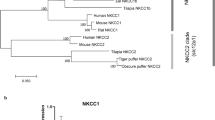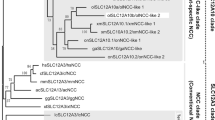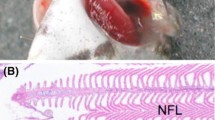Abstract
The inner opercular membranes of the brackish medaka, Oryzias dancena, have numerous ionocytes, similar to the gill epithelia. By histological observation, this study demonstrated that it is possible to investigate the cellular morphology and function of ionocytes in the opercular membrane. The mitochondria-rich ionocytes in the opercular membranes were traced using rhodamine 123 and a cytochrome c oxidase IV antibody in vital and fixed situations, respectively. To validate different morphologies of seawater (SW)-type and freshwater (FW)-type ionocytes of the opercular membrane of euryhaline brackish medaka, a method of dual observation including immunofluorescence staining and subsequent scanning electron microscopy was used. The apical morphologies of SW- and FW-type ionocytes were hole and flat opening, respectively. In addition, the microvilli were found on the apical surface of the FW-type ionocytes. The SW-type ionocytes exhibited basolateral Na+, K+, 2Cl− cotransporter and the apical cystic fibrosis transmembrane conductance regulator. In contrast, in the apical region of FW-type ionocytes, Na+, Cl− cotransporter and villin 1-like protein were expressed. In addition, histochemical staining of AgCl precipitation counterstained with a Na+, K+-ATPase α-subunit antibody on the opercular membrane illustrated the role of Cl− secretion in the SW-type ionocytes of the brackish medaka. A combination of different observations in this study indicated that the opercular membrane could be a useful surrogate model for histological and functional studies on the epithelial ionocytes of fish gills.









Similar content being viewed by others
References
Aschrafi A, Schwechter AD, Mameza MG, Natera-Naranjo O, Gioio AE, Kaplan BB (2008) MicroRNA-338 regulates local cytochrome c oxidase IV mRNA levels and oxidative phosphorylation in the axons of sympathetic neurons. J Neurosci 28:12581–12590
Chacko AD, Liberante F, Paul I, Longley DB, Fennell DA (2010) Voltage dependent anion channel-1 regulates death receptor mediated apoptosis by enabling cleavage of caspase-8. BMC Cancer 10:380
Choi JH, Lee KM, Inokuchi M, Kaneko T (2011) Morphofunctional modifications in gill mitochondria-rich cells of Mozambique tilapia transferred from freshwater to 70% seawater, detected by dual observations of whole-mount immunocytochemistry and scanning electron microscopy. Comp Biochem Physiol A 158:132–142
Degnan KJ, Karnaky KJ, Zadunaisky JA (1977) Active chloride transport in the in vitro opercular skin of a teleost (Fundulus heteroclitus), a gill-like epithelium rich in chloride cells. J Physiol 271:155–191
Dickson JS, Dillaman RM, Roer RD, Roye DB (1991) Distribution and characterization of ion transporting and respiratory filaments in the gills of Procambarus clarkii. Biol Bull 180:154–166
Evans DH (2008) Teleost fish osmoregulation: what have we learned since August Krogh, Homer Smith, and Ancel Keys. Am J Physiol 295:R704–R713
Evans DH (2011) Freshwater fish gill ion transport: august Krogh to morpholinos and microprobes. Acta Physiol 202:349–359
Evans DH, Piermarini PM, Potts WTW (1999) Ionic transport in the fish gill epithelium. J Exp Zool 283:641–652
Evans DH, Piermarini PM, Choe KP (2005) The multifunctional fish gill: dominant site of gas exchange, osmoregulation, acid-base regulation, and excretion of nitrogenous waste. Physiol Rev 85:97–177
Foskett JK, Scheffey C (1982) The chloride cell: definitive identification as the salt-secretory cell in teleosts. Science 215:164–166
Graham A (2003) Development of the pharyngeal arches. Am J Med Genet A 119:251–256
Hirose S, Kaneko T, Naito N, Takei Y (2003) Molecular biology of major components of chloride cells. Comp Biochem Physiol B 136:593–620
Horng JL, Lin LY, Huang CJ, Katoh F, Kaneko T, Hwang PP (2007) Knockdown of V-ATPase subunit A (atp6v1a) impairs acid secretion and ion balance in zebrafish (Danio rerio). Am J Physiol 292:R2068–R2076
Horng JL, Hwang PP, Shih TH, Wen ZH, Lin CS, Lin LY (2009) Chloride transport in mitochondrion-rich cells of euryhaline tilapia (Oreochromis mossambicus) larvae. Am J Physiol 297:C845–C854
Hossler FE, Ruby JR, Mcilwain TD (1979) Gill Arch of the mullet, Mugil cephalus modification in surface ultrastructure and Na, K-ATPase content during adaptation to various salinities. J Exp Zool 208:399–405
Hsiao CD, You MS, Guh YJ, Ma M, Jiang YJ, Hwang PP (2007) A positive regulatory loop between foxi3a and foxi3b is essential for specification and differentiation of zebrafish epidermal ionocytes. PLoS ONE 2:e302
Hwang PP, Lee TH (2007) New insights into fish ion regulation and mitochondrionrich cells. Comp Biochem Physiol A 148:479–497
Hwang PP, Lee TH, Lin LY (2011) Ion regulation in fish gills: recent progress in the cellular and molecular mechanisms. Am J Physiol 301:R28–R47
Inoue K, Takei Y (2002) Diverse adaptability in Oryzias species to high environmental salinity. Zool Sci 19:727–734
Inoue K, Takei Y (2003) Asian medaka fishes offer new models for studying mechanisms of seawater adaptation. Comp Biochem Physiol B 136:635–645
Johnson LV, Walsh ML, Chen LB (1980) Localization of mitochondria in living cells with rhodamine 123. Proc Natl Acad Sci USA 77:990–994
Kaneko T, Shiraishi K (2001) Evidence for chloride secretion from chloride cells in the yolk-sac membrane of Mozambique tilapia larvae adapted to seawater. Fish Sci 67:541–543
Kaneko T, Watanabe S, Lee KM (2008) Functional morphology of mitochondrion-rich cells in euryhaline and stenohaline teleosts. Aqua-BioSci Monogr 1:1–62
Kang CK, Lee TH (2014) Medaka villin 1-like protein (VILL) is associated with the formation of microvilli induced by decreasing salinities in the absorptive ionocytes. Front Zool 11:2
Kang CK, Tsai SC, Lee TH, Hwang PP (2008) Differential expression of branchial Na+/K+-ATPase of two medaka species, Oryzias latipes and Oryzias dancena, with different salinity tolerances acclimated to fresh water, brackish water and seawater. Comp Biochem Physiol A 148:479–497
Kang CK, Tsai HJ, Liu CC, Lee TH, Hwang PP (2010) Salinity-dependent expression of a Na+/K+ 2Cl− cotransporter in gills of the brackish medaka Oryzias dancena: a molecular correlate for hyposmoregulatory endurance. Comp Biochem Physiol A 157:7–18
Kang CK, Tsai SC, Lin ST, Lee TH, Hwang PP (2012) Cystic fibrosis transmembrane conductance regulator (CFTR): an apical marker protein of ionocytes for identifying hypoosmoregulation in gills of the euryhaline medaka, Oryzias dancena. Zool Stud 51:1270–1281
Kang CK, Yang WK, Lin ST, Liu CC, Lin HM, Chen HH, Cheng CW, Lee TH, Hwang PP (2013) The acute and regulatory phases of time-course changes in gill mitochondrion-rich cells of seawater-acclimated medaka (Oryzias dancena) when exposed to hypoosmotic environments. Comp Biochem Physiol A 164:181–191
Karnaky KJ, Kinter WB (1977) Killifish opercular skin: a flat epithelium with a high density of chloride cells. J Exp Zool 199:355–364
Karnaky KJ, Degnan KJ, Zadunaisky JA (1977) Chloride transport across isolated opercular epithelium of killifish: a membrane rich in chloride cells. Science 195:203–205
Katoh F, Kaneko T (2003) Short-term transformation and long-term replacement of branchial chloride cells in killifish transferred from seawater to freshwater, revealed by morphofunctional observations and a newly established time-differential double fluorescent staining technique. J Exp Biol 206:4113–4123
Katoh F, Hasegawa S, Kita J, Takagi Y, Kaneko T (2001) Distinct seawater and freshwater types of chloride cells in killifish, Fundulus heteroclitus. Can J Zool 79:822–829
King JAC, Hossler FE (1991) The gill arch of the striped bass (Morone saxatilis). Alterations in the ultrastructure of chloride cell apical crypts and chloride efflux following exposure to seawater. J Morphol 209:165–176
Lee TH, Hwang PP, Lin HC, Huang FL (1996) Mitochondria-rich cells in the branchial epithelium of the teleost, Oreochromis mossambicus, acclimated to various hypotonic environment. Fish Physiol Biochem 15:513–523
Lee KM, Yamada Y, Okamura A, Tsukamoto K, Kaneko T (2013) Hyposmoregulatory ability and ion-and water-regulatory mechanisms during the leptocephalus stages of Japanese eel Anguilla japonica. Fish Sci 79:77–86
Li Y, D’Aurelio M, Deng JH, Park JS, Manfredi G, Hu P, Lu J, Bai Y (2007) An assembled complex IV maintains the stability and activity of complex I in mammalian mitochondria. J Biol Chem 282:17557–17562
Lin LY, Horng JL, Kunkel JG, Hwang PP (2006) Proton pump-rich cell secretes acid in skin of zebrafish larvae. Am J Physiol 290:C371–C378
Marshall WS (2002) Na+, Cl−, Ca2+ and Zn2+ transport by fish gills: retrospective review and prospective synthesis. J Exp Zool 293:264–283
Marshall WS, Bryson SE, Luby T (2000) Control of epithelial Cl (−) secretion by basolateral osmolality in the euryhaline teleost Fundulus heteroclitus. J Exp Biol 203:1897–1905
Marshall WS, Lynch EM, Cozzi RRF (2002) Redistribution of immunofluorescence of CFTR anion channel and NKCC cotransporter in chloride cells during adaptation of the killifish Fundulus heteroclitus to sea water. J Exp Biol 205: 1265–1273
Marshall WS, Katoh F, Main HP, Sers N, Cozzi RR (2008) Focal adhesion kinase and beta1 integrin regulation of Na+, K+, 2Cl– cotransporter in osmosensing ion transporting cells of killifish, Fundulus heteroclitus. Comp Biochem Physiol A 150:288–300
Mazon ADF, Nolan DT, Lock RA, Wendelaar Bonga SE, Fernandes MN (2007) Opercular epithelial cells: a simple approach for in vitro studies of cellular responses in fish. Toxicology 230:53–63
Perry SF (1997) The chloride cell: structure and function in the gills of freshwater fishes. Annu Rev Physiol 59:325–347
Roberts TR (1998) Systematic observations on tropical Asian medakas or ricefishes of the genus Oryzias with descriptions of four new species. Ichthyol Res 45:213–224
Scott GR, Claiborne JB, Edwards SL, Schulte PM, Wood CM (2005) Gene expression after freshwater transfer in gills and opercular epithelia of killifish: insight into divergent mechanisms of ion transport. J Exp Biol 208:2719–2729
Scott GR, Baker DW, Schulte PM, Wood CM (2008) Physiological and molecular mechanisms of osmoregulatory plasticity in killifish after seawater transfer. J Exp Biol 211:2450–2459
Shen WP, Horng JL, Lin LY (2011) Functional plasticity of mitochondrion-rich cells in the skin of euryhaline medaka larvae (Oryzias latipes) subjected to salinity changes. Am J Physiol 300: R858–R868
Shieh YE, Tsai RS, Hwang PP (2003) Morphological modification of mitochondria-rich cells of the opercular epithelium of freshwater tilapia, Oreochromis mossambicus, acclimated to low chloride levels. Zool Stud 42:522–528
Soukup V, Horácek I, Cerny R (2013) Development and evolution of the vertebrate primary mouth. J Anat 222:79–99
Tang CH, Lee TH (2011) Morphological and ion-transporting plasticity of branchial mitochondrion-rich cells in the euryhaline spotted green pufferfish, Tetraodon nigroviridis. Zool Stud 50:31–42
Thermes V, Lin CC, Hwang PP (2010) Expression of Ol-foxi3and Na+/K+-ATPase in ionocytes during the development of euryhaline medaka (Oryzias latipes) embryos. Gene Expr Patterns 10:185–192
Tse WK, Au DW, Wong CK (2006) Characterization of ion channel and transporter mRNA expressions in isolated gill chloride and pavement cells of seawater acclimating eels. Biochem Biophys Res Co 346:1181–1190
Uchida K, Kaneko T, Miyazaki H, Hasegawa S, Hirano T (2000) Excellent salinity tolerance of Mozambique tilapia (Oreochromis mossambicus): elevated chloride cell activity in the branchial and opercular epithelia of the fish adapted to concentrated seawater. Zool Sci 17:149–160
Wong CK, Chan DK (1999) Isolation of viable cell types from the gill epithelium of Japanese eel Anguilla japonica. Am J Physiol 276:R363–R372
Wood CM, Marshall WS (1994) Ion balance, acid-base regulation, and chloride cell function in the common killifish, Fundulus heteroclitus-a euryhaline estuarine teleosts. Estuaries 17:34–52
Acknowledgments
The monoclonal antibodies, T4 and α5, were purchased from the Developmental Studies Hybridoma Bank (DSHB) maintained by the Department of Pharmacology and Molecular Sciences, John Hopkins University School of Medicine, Baltimore, MD 2120521205, and the Department of Biological Sciences, University of Iowa, Iowa City, IA 52242, under Contract N01-HD-6-2915, NICHD, USA. This study was supported by a Grant from the Ministry of Science and Technology (MOST), Taiwan, to T.H.L. (NSC 102-2321-B-005-011-MY3). K.C.K. was supported by a MOST postdoctoral fellowship (NSC102-2811-B-005-024).
Author information
Authors and Affiliations
Corresponding author
Electronic supplementary material
Below is the link to the electronic supplementary material.
Rights and permissions
About this article
Cite this article
Kang, CK., Yang, SY., Lin, ST. et al. The inner opercular membrane of the euryhaline teleost: a useful surrogate model for comparisons of different characteristics of ionocytes between seawater- and freshwater-acclimated medaka. Histochem Cell Biol 143, 69–81 (2015). https://doi.org/10.1007/s00418-014-1266-2
Accepted:
Published:
Issue Date:
DOI: https://doi.org/10.1007/s00418-014-1266-2




